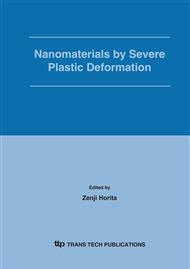[1]
Y. Kawamura, K. Hayashi and A. Inoue: Mater. Trans. Vol. 42 (2001), p.1172.
Google Scholar
[2]
K. Hayashi: Development of Rapidly Solidified Powder Metallurgy Magnesium Alloys with Relative Intensity 100 100 100 100.
Google Scholar
[16]
[16] [19] [6] [55] [48] [37] [31] 8P 4P 2P 1P Plane (hkil) Relative Intensity 100 100 100 100.
Google Scholar
[16]
[16] [19] [6] [55] [48] [37] [31] 8P 4P 2P 1P Plane (hkil) a) Transverse section 0110 0002 1110 100 100 100 100 Relative Intensity.
Google Scholar
[47]
[82] [58] [78] [32] [23] [16] [11] 8P 4P 2P 1P Plane (hkil) 100 100 100 100 Relative Intensity.
Google Scholar
[47]
[82] [58] [78] [32] [23] [16] [11] 8P 4P 2P 1P Plane (hkil) b) Longitudinal section 0110 0002 1110 Table 1 The relative intensity of XRD peaks taken from a) transverse section and b) longitudinal section of the Mg97Zn1Y2 alloy ECAE-processed at 623 K. )( 0110 )( 1110 )( 0110 1110(High Strength (Master thesis, Tohoku University, 2001).
Google Scholar
[3]
E. Abe, Y. Kawamura, K. Hayashi and A. Inoue: Acta Mater. Vol. 50 (2002), p.3845.
Google Scholar
[4]
D. H. Ping, K. Hono, Y. Kawamura and A. Inoue: Philos. Mag. Lett.,. Vol. 82 (2002), p.543.
Google Scholar
[5]
Z. P. Luo and S. Q. Zhang: J. Mater. Sci. Lett., Vol. 19 (2000), p.813.
Google Scholar
[6]
Z. P. Luo, S. Q. Zhang, Y. L. Tang, and D. S. Zhao: J. Alloys Comp., Vol. 209 (1994), p.275.
Google Scholar
[7]
T. Itoi, T. Seimiya, Y. Kawamura and M. Hirohashi: Scr. Mater., Vol. 51 (2004), p.107.
Google Scholar
[8]
Y. Kawamura, S. Yoshimoto: Magnesium Technology 2005 (TMS, Warrendale, Pennsylvania, 2005), pp.499-502.
Google Scholar
[9]
K. Matsubara, Y. Miyahara, Z. Horita and T. G. Langdon: Acta Mater. Vol. 51 (2003), p.3073.
Google Scholar
[10]
K. Matsubara, Y. Miyahara, K. Makii, Z. Horita and T. G. Langdon: Mater. Sci. Forum Vols. 419-422 (2003), p.497.
DOI: 10.4028/www.scientific.net/msf.419-422.497
Google Scholar
[11]
Y. Miyahara, K. Matsubara, K. Neishi, Z. Horita and T. G. Langdon: Mater. Sci. Forum Vols 419-422 (2003), p.551.
Google Scholar
[12]
T. Mukai, M. Yamanoi, H. Watanabe and K. Higashi: Scr. Mater., Vol. 45 (2001), p.89.
Google Scholar


